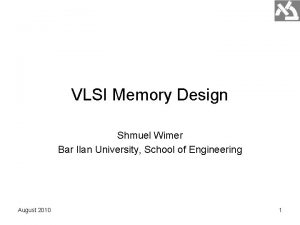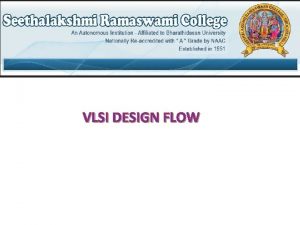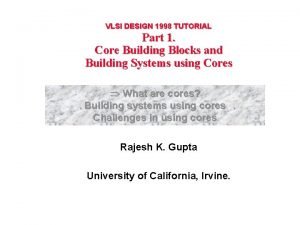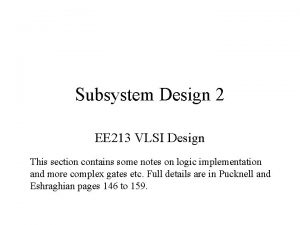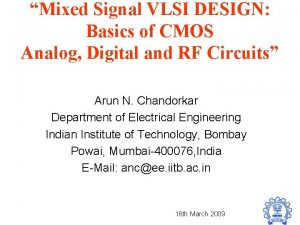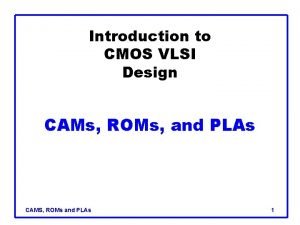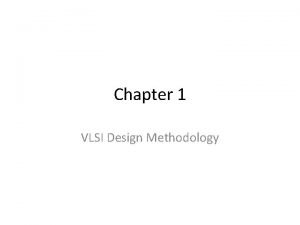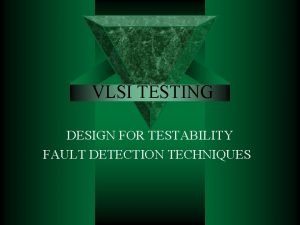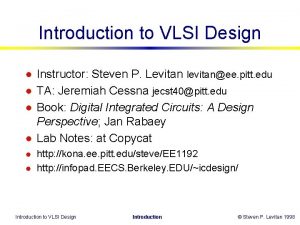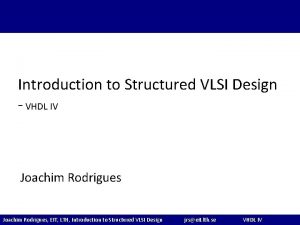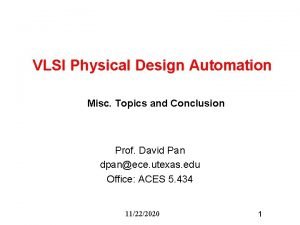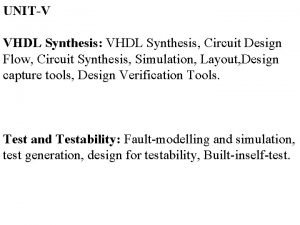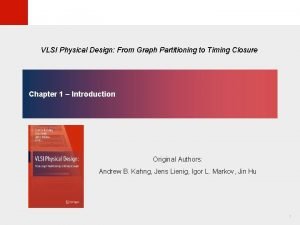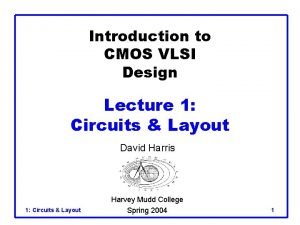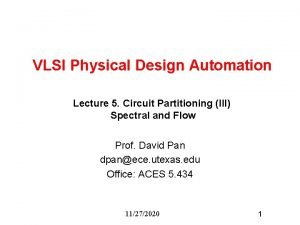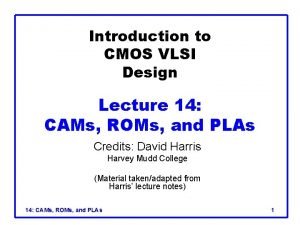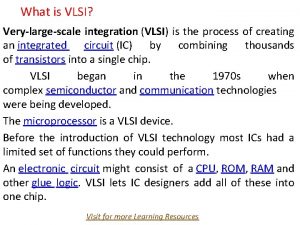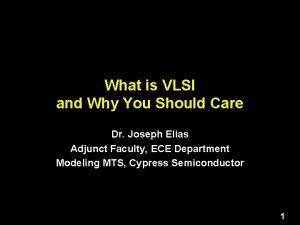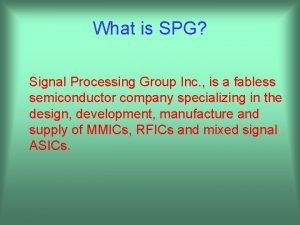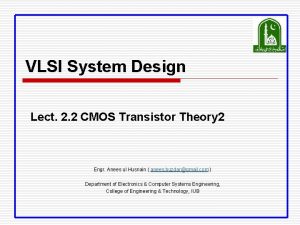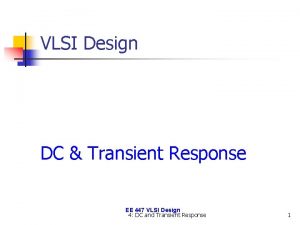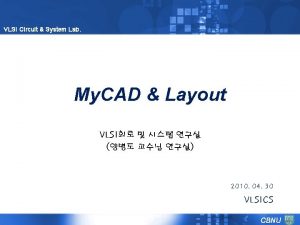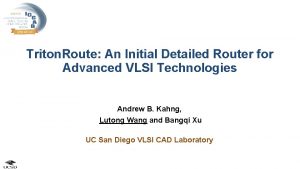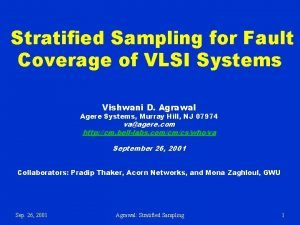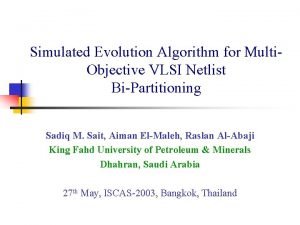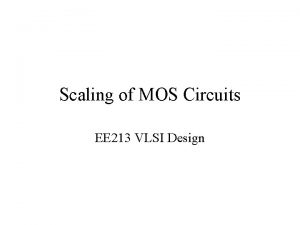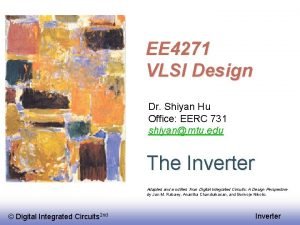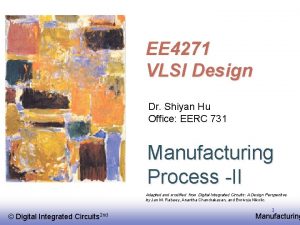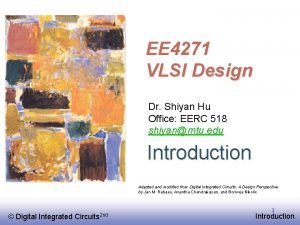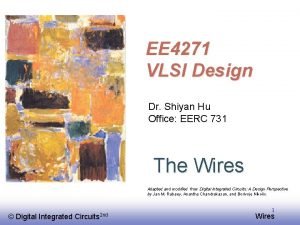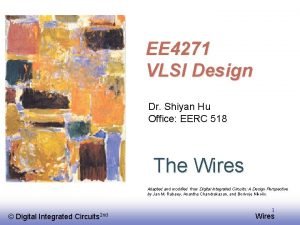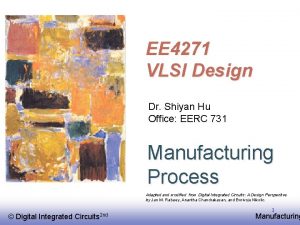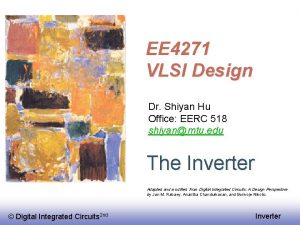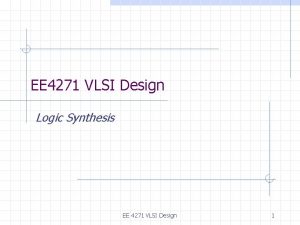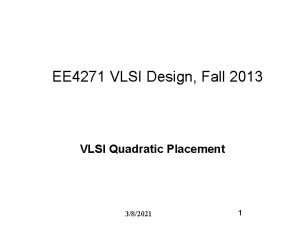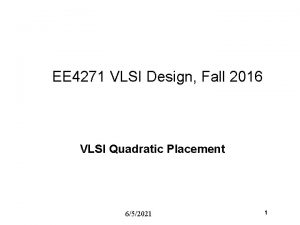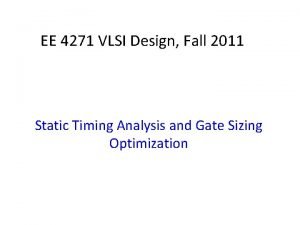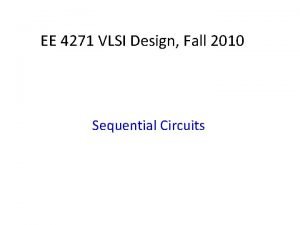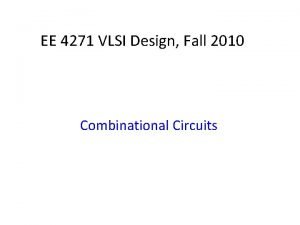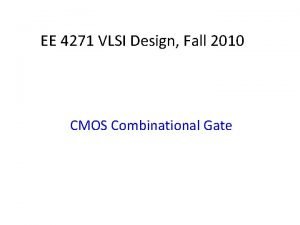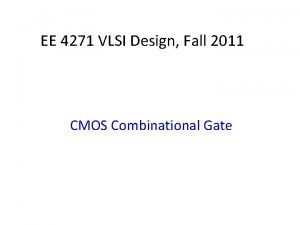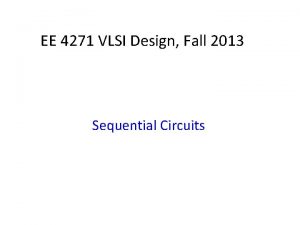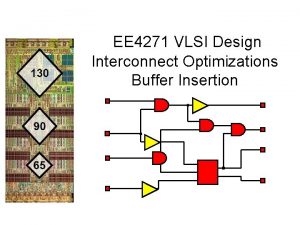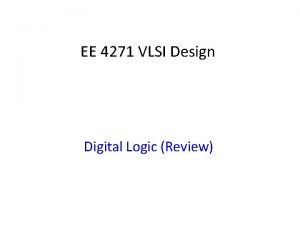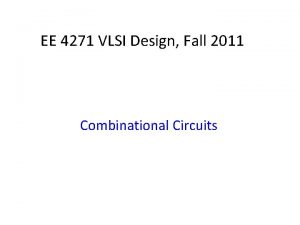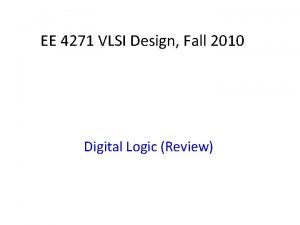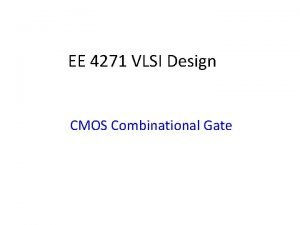EE 4271 VLSI Design Professor Shiyan Hu Office





































- Slides: 37

EE 4271 VLSI Design Professor Shiyan Hu Office: EERC 518 shiyan@mtu. edu Introduction Adapted and modified from Digital Integrated Circuits: A Design Perspective by Jan M. Rabaey, Anantha Chandrakasan, and Borivoje Nikolic. © EE 141 Digital Integrated Circuits 2 nd 1 Introduction

Class Time and Office Hour q q q Class Time: MWF 16: 05 -16: 55 (EERC 214) Office Hours: MWF 15: 00 -16: 00 or by appointment, office: EERC 518 Textbook (required): Digital Integrated Circuits: A Design Perspective, second edition, by Jan M. Rabaey, Anantha Chandrakasan and Borivoje Nikolic, Prentice Hall, 2003. or CMOS VLSI Design: A Circuits and Systems Perspective, fourth edition, by Neil H. E. Weste and David M. Harris, Addiuson Wesley, 2009 Grading: § § Homework 20% Midterm 20% Final 30% Lab 30% © EE 141 Digital Integrated Circuits 2 nd 2 Introduction

Course Website q q http: //www. ece. mtu. edu/faculty/shiyan/EE 4271 Fall 16. htm Contact information of instructor § § Professor Shiyan Hu Email: shiyan@mtu. edu EERC 518 Instructor’s webpage: http: //www. ece. mtu. edu/faculty/shiyan © EE 141 Digital Integrated Circuits 2 nd 3 Introduction

What is this course all about? q Introduction to digital integrated circuits. § CMOS devices and manufacturing technology. CMOS inverters and gates. Propagation delay, noise margins, and power dissipation. Combinatorial Circuits and Sequential circuits. Computer-Aided Design. q What will you learn? § Understanding, designing, and optimizing digital circuits with respect to different quality metrics: speed, power dissipation, cost, and reliability © EE 141 Digital Integrated Circuits 2 nd 4 Introduction

Agenda q q q q q Introduction: Issues in digital integrated circuit (IC) design Device: MOS Transistors Wire: R, L and C Fabrication process CMOS inverter Combinational logic structures Sequential logic gates Design methodologies VLSI Computer-Aided Design Timing/power optimizations on gate and interconnect © EE 141 Digital Integrated Circuits 2 nd 5 Introduction

Introduction q Why is designing digital ICs different today than it was before? q What is the challenge? © EE 141 Digital Integrated Circuits 2 nd 6 Introduction

The Transistor Revolution First transistor Bell Labs, 1948 © EE 141 Digital Integrated Circuits 2 nd Introduction

The First Integrated Circuit First IC Jack Kilby Texas Instruments 1958 © EE 141 Digital Integrated Circuits 2 nd Introduction

Intel 4004 Micro-Processor 1971 1000 transistors 1 MHz operation © EE 141 Digital Integrated Circuits 2 nd 9 Introduction

Intel 8080 Micro-Processor 1974 4500 transistors © EE 141 Digital Integrated Circuits 2 nd Introduction

Intel Pentium (IV) microprocessor 2000 42 million transistors 1. 5 GHz © EE 141 Digital Integrated Circuits 2 nd 11 Introduction

Modern Chip © EE 141 Digital Integrated Circuits 2 nd Introduction

Moore’s Law l. In 1965, Gordon Moore noted that the number of transistors on a chip doubled every 18 to 24 months. © EE 141 Digital Integrated Circuits 2 nd 13 Introduction

Moore’s law Twice the number of transistors, approximately every two years © EE 141 Digital Integrated Circuits 2 nd Introduction

Moore’s Law Electronics, April 19, 1965. © EE 141 Digital Integrated Circuits 2 nd 15 Introduction

Transistor Counts 1 Billion Transistors K 1, 000 100, 000 1, 000 i 386 80286 100 10 i 486 Pentium® III Pentium® Pro Pentium® 8086 Source: Intel 1 1975 1980 1985 1990 1995 2000 2005 2010 Projected © EE 141 Digital Integrated Circuits 2 nd Courtesy, Intel 16 Introduction

ITRS Prediction © EE 141 Digital Integrated Circuits 2 nd 17 Introduction

Moore’s law in Microprocessors Transistors (MT) 1000 2 X growth in 1. 96 years! 100 10 486 1 P 6 Pentium® proc 386 286 0. 1 8086 8080 8008 4004 8085 Transistors on Lead Microprocessors double every 2 years 0. 01 0. 001 1970 © EE 141 Digital Integrated 1980 Circuits 2 nd 1990 Year Courtesy, Intel 2000 2010 18 Introduction

Frequency Not true any more! Frequency (Mhz) 10000 Doubles every 2 years 1000 10 8085 1 0. 1 1970 8086 286 386 486 P 6 Pentium ® proc 8080 8008 4004 1980 1990 Year 2000 2010 Lead Microprocessors frequency doubles every 2 years © EE 141 Digital Integrated Circuits 2 nd Courtesy, Intel 19 Introduction

Interconnects Dominate Delay (psec) 300 250 Interconnect delay 200 150 100 Transistor/Gate delay 50 0 0. 8 25. 18. 15. 0. 35 0. 25 0 0 0 Technology generation ( m) 0. 5 Source: Gordon Moore, Chairman Emeritus, Intel Corp. © EE 141 Digital Integrated Circuits 2 nd 20 Introduction

Power Dissipation Power (Watts) 100 P 6 Pentium ® proc 10 8086 286 1 8008 4004 486 386 8085 8080 0. 1 1974 1978 1985 1992 2000 Year Lead Microprocessors power continues to increase © EE 141 Digital Integrated Circuits 2 nd Courtesy, Intel 21 Introduction

Power is a major problem 100000 18 KW 5 KW 1. 5 KW 500 W Power (Watts) 10000 1000 Pentium® proc 100 286 486 8086 10 386 8085 8080 8008 1 4004 0. 1 1974 1978 1985 1992 2000 2004 2008 Year Power delivery and dissipation will be prohibitive © EE 141 Digital Integrated Circuits 2 nd Courtesy, Intel 22 Introduction

Power density Power Density (W/cm 2) 10000 Rocket Nozzle 1000 Nuclear Reactor 100 8086 10 4004 Hot Plate P 6 8008 8085 Pentium® proc 386 286 486 8080 1 1970 1980 1990 2000 2010 Year Power density too high to keep junctions at low temp © EE 141 Digital Integrated Circuits 2 nd Courtesy, Intel 23 Introduction

Not Only Microprocessors Cell Phone Small Signal RF Digital Cellular Market (Phones Shipped) Power RF Power Management 1996 1997 1998 1999 2000 Units 48 M 86 M 162 M 260 M 435 M Analog Baseband Digital Baseband (DSP + MCU) (data from Texas Instruments) © EE 141 Digital Integrated Circuits 2 nd 24 Introduction

Many Chips © EE 141 Digital Integrated Circuits 2 nd 25 Introduction

Challenges in Digital Design • Ultra-high speed design • Interconnect delay • Reliability, Manufacturability • Power Dissipation • Time to market © EE 141 Digital Integrated Circuits 2 nd 26 Introduction

10, 000 100, 000, 000 Logic Tr. /Chip Tr. /Staff Month. 1, 000, 000 10, 000 100, 000 Productivity (K) Trans. /Staff - Mo. Complexity Logic Transistor per Chip (M) Productivity Trends 1, 000, 000 58%/Yr. compounded Complexity growth rate 10 10, 000 100, 000 1, 0001 10 10, 000 x 0. 1 100 xx 0. 01 10 xx x x 1 1, 000 21%/Yr. compound Productivity growth rate x 0. 1 100 0. 01 10 2009 2007 2005 2003 2001 1999 1997 1995 1993 1991 1989 1987 1985 1983 1981 0. 001 1 Source: Sematech Complexity outpaces design productivity © EE 141 Digital Integrated Circuits 2 nd Courtesy, ITRS Roadmap 27 Introduction

Computer-Aided Design q Every new generation can integrate 2 x more functions per chip § Chip price does not increase significantly § Cost of a function decreases by 2 x q However, § Design engineering population does not double every two years. § How to design much more complex chips (with more and more functions)? q Great need for ultra-fast design methods § Design Automation (Computer-Aided Design) © EE 141 Digital Integrated Circuits 2 nd 28 Introduction

Design Abstraction Enables CAD SYSTEM MODULE + GATE CIRCUIT DEVICE G S n+ © EE 141 Digital Integrated Circuits 2 nd D n+ 29 Introduction

Design Metrics q How to evaluate performance of a digital circuit (gate, block, …)? § Speed (delay, operating frequency) § Power dissipation § Cost – Design time – Design effort § Reliability – Process, voltage and temperature variations © EE 141 Digital Integrated Circuits 2 nd 30 Introduction

Cost of Integrated Circuits q NRE (non-recurrent engineering) costs § design time and effort to design layout and mask § one-time cost factor q Recurrent costs § silicon processing, packaging, test § proportional to volume § proportional to chip area © EE 141 Digital Integrated Circuits 2 nd 31 Introduction

NRE Cost is Increasing © EE 141 Digital Integrated Circuits 2 nd 32 Introduction

Die Cost Single die Wafer Going up to 12” (30 cm) From http: //www. amd. com © EE 141 Digital Integrated Circuits 2 nd 33 Introduction

Yield © EE 141 Digital Integrated Circuits 2 nd 34 Introduction

Defects a is approximately 3 in the current fabrication process About 0. 5 -1 defect per cm 2. © EE 141 Digital Integrated Circuits 2 nd 35 Introduction

Some Examples (1994) Chip Metal Line layers width Wafer cost Def. / Area Dies/ Yield cm 2 mm 2 wafer Die cost 386 DX 2 0. 90 $900 1. 0 43 360 71% $4 486 DX 2 3 0. 80 $1200 1. 0 81 181 54% $12 Power PC 601 4 0. 80 $1700 1. 3 121 115 28% $53 HP PA 7100 3 0. 80 $1300 1. 0 196 66 27% $73 DEC Alpha 3 0. 70 $1500 1. 2 234 53 19% $149 Super Sparc 3 0. 70 $1700 1. 6 256 48 13% $272 Pentium 3 0. 80 $1500 1. 5 296 40 9% $417 © EE 141 Digital Integrated Circuits 2 nd 36 Introduction

Summary q Digital integrated circuit design faces huge challenges for the coming decades § High speed § Low power § Short design time for highly complex circuit having 1 billion transistors § Reliable under noise and variations q Purpose of the course § Understand the basics of VLSI design § Getting a clear perspective on the challenges and potential solutions © EE 141 Digital Integrated Circuits 2 nd 37 Introduction
 Ic 4271
Ic 4271 Shiyan 3
Shiyan 3 Promotion from assistant to associate professor
Promotion from assistant to associate professor Memory design in vlsi
Memory design in vlsi Vlsi flow design
Vlsi flow design Vlsi design tutorial
Vlsi design tutorial Subsystem design in vlsi notes
Subsystem design in vlsi notes Mixed signal vlsi design
Mixed signal vlsi design Rom design in vlsi
Rom design in vlsi Vlsi design tutorial
Vlsi design tutorial Y chart in vlsi design
Y chart in vlsi design Layout design rules in cmos vlsi
Layout design rules in cmos vlsi Y chart in vlsi
Y chart in vlsi Ad hoc testable design techniques
Ad hoc testable design techniques Introduction to vlsi
Introduction to vlsi Structured vlsi design
Structured vlsi design Vlsi physical design automation
Vlsi physical design automation Vlsi design styles
Vlsi design styles Design flow
Design flow Vlsi design flow
Vlsi design flow O3ai gate
O3ai gate çç
çç Cmos vlsi design lecture notes
Cmos vlsi design lecture notes Rom design in vlsi
Rom design in vlsi Office in factory
Office in factory What is vlsi
What is vlsi What is this
What is this Spg in vlsi
Spg in vlsi Vlsi transistor
Vlsi transistor Clock skew
Clock skew Lambda based design rules
Lambda based design rules Transient response in vlsi
Transient response in vlsi Scmos
Scmos Vlsi ppt presentation
Vlsi ppt presentation Routing direction
Routing direction Fault coverage in vlsi
Fault coverage in vlsi Evolution of vlsi
Evolution of vlsi Scaling factor in vlsi
Scaling factor in vlsi



